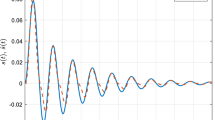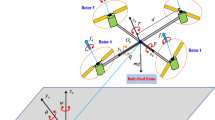Abstract
In this paper, a new fault diagnosis and fault-tolerant control method for a class of active suspension systems with actuator faults is proposed. The considered actuators have uncertain dynamic characteristics, which are the electromagnetic actuators made up with a motor control system and a ball screw transmission mechanism. To detect such suspension system actuator faults, dynamic fault diagnosis observers are designed for the actuators to estimate the possible faults. The actuators are analyzed to first and second order dynamic models, respectively, whose output can be measured but the rate is non-measurable. Then, the fault diagnosis method is developed for these two kinds of models to obtain the fault information. Using the fault estimation and adaptive control technique, a robust fault-tolerant controller is constructed to guarantee the performance of the rail vehicles in the faulty case. Finally, using the parameters of a practical suspension system, a simulation study is conducted to show the effectiveness of the proposed method.
Similar content being viewed by others
Abbreviations
- m p :
-
The mass of the power carbody
- m t :
-
The mass of the trailer carbody
- m pb :
-
The mass of the power bogie
- m tb :
-
The mass of the trailer bogie
- I p :
-
The pitch inertia of the power carbody
- I t :
-
The pitch inertia of the trailer carbody
- d 1 :
-
The distance between the center of gravity and the suspension position of the power carbody
- d 2 :
-
The distance between the center of gravity and the rear position of the power carbody
- d 3 :
-
The distance between the center of gravity and the end position of the trailer carbody
- k :
-
The spring constant of the articulation
- k 1 :
-
The spring constant of the secondary suspension of the power carbody
- k 2 :
-
The spring constant of the secondary suspension of the trailer carbody
- k 3 :
-
The spring constant of the secondary suspension of the power bogie
- k 4 :
-
The spring constant of the secondary suspension of the trailer bogie
- c 1 :
-
The camping constant of the secondary suspension of the power carbody
- c 2 :
-
The camping constant of the secondary suspension of the trailer carbody
- c 3 :
-
The camping constant of the secondary suspension of the power bogie
- c 4 :
-
The camping constant of the secondary suspension of the trailer bogie
- f 1, f 2, f 3 :
-
The active control forces
- y 1, y 2, y 3 :
-
The vertical displacements of the center of gravity of car1, car2 and car3
- q 1, q 2, q 3 :
-
The pitch angles of the center of gravity of car1, car2 and car3
- y 4, y 5, y 6 :
-
The vertical displacements of the center of gravity of bogie1, bogie2 and bogie3
- y 7, y 8, y 9 :
-
The disturbances caused by track irregularity for bogie1, bogie2 and bogie3
- y 10, y 11 :
-
The displacements of suspension position of the power carbody
- y 12, y 23 :
-
The displacements of articulation position of the power carbody
- y 13, y 24 :
-
The displacements of articulation position of the trailer carbody
- R :
-
The phase resistance
- L :
-
The winding self-inductance
- M :
-
The winding mutual inductance
- I :
-
The identity matrix of appropriate dimensions
- O :
-
The zero matrix of appropriate dimensions
References
W. C. Sun, Active Vibration Control for Vehicle Suspension Systems, Harbin Institute of Technology, Harbin, 2013.
Y. C. Zhang, Study on Robust Control for Vehicle Active Electromagnetic Suspension, Shanghai Jiao Tong University, Shanghai, 2012.
W. C. Sun, H. J. Gao, and O. Kaynak, “Finite frequency H ∞ control for vehicle active suspension systems,” IEEE Trans. on Control Systems Technology, vol. 19, no. 2, pp. 416–422, 2011. [click]
W. C. Sun, Y. Zhao, J. F. Li, L. X. Zhang, and H. J. Gao, “Active suspension control with frequency band constraints and actuator input delay,” IEEE Trans. on Industrial Electronics, vol. 59, no. 1, pp. 530–537, 2012. [click]
X. K. Wei, S. Lin and H. Liu, “Distributed fault detection observer for rail vehicle suspension systems,” Proc. of the 24th Chinese Control and Decision Conf., pp. 3396–3401, 2012. [click]
Y. Wang, Z. H. Mao and B. Jiang, “Observer-based fault detection for rail vehicle suspension systems,” Proc. of Chinese Control and Design Conf., pp. 2863–2868, 2014. [click]
H. J. Gao, W. C. Sun, and P. Shi, “Robust sampled-data H ∞ control for vehicle active suspension systems,” IEEE Trans. on Control Systems Technology, vol. 18, no. 1, pp. 238–245, January 2010.
H. F. Guo, J. Qiu, H. Tian, and H. J. Gao, “Fault detection of discrete-time T-S fuzzy affine systems based on piecewise Lyapunov functions,” Journal of the Franklin Institute, vol. 351, no. 7, pp. 3633–3650, 2014.
J. Li, H. W. Gao, P. Zhang, and D. R. Huang, “Fault diagnosis and optimal fault-tolerant control for systems with delayed measurements and states,” International Journal of Control, Automation and Systems, vol. 10, no. 1, pp. 150–157, 2012. [click]
H. Wang and G. H. Yang, “Fault estimations for uncertain linear discrete-time systems in low frequency domain,” Proc. of the 2007 American Control Conf., pp. 1124–1129, 2007. [click]
M. Y. Zhong, Y. X. Liu, and Z. Y. Huo, “H ∞ fault estimation and accommodation for LTI systems,” Proc. of the 7th World Congress on Intelligent Control and Automation, pp. 1806–1809, 2008.
D. S. Du, B. Jiang, and V. Cocquempot, “Fault estimation and accommodation for switched systems with timevarying delay,” International Journal of Control, Automation and Systems, vol. 9, no. 3, pp. 442–451, 2011.
X. Y. Wen, L. Guo, and P. Yan, “Composite hierarchical anti-disturbance control for robotic systems with multiple disturbances,” International Journal of Control, Automation and Systems, vol. 12, no. 3, pp. 541–551, 2014. [click]
X. L. Yao, G. Tao, and R. Y. Qi, “Adaptive actuator failure compensation and disturbance rejection scheme for spacecraft,” Journal of Systems Engineering and Electronics, vol. 25, no. 4, pp. 648–659, 2014. [click]
X. G. Yan, S. K. Spurgeon, and C. Edwards, “Memoryless static output feedback sliding mode control for nonlinear systems with delayed disturbances,” IEEE Transactions on Automatic Control, vol. 59, no. 7, pp. 1906–1911, 2014.
G. H. Yang and D. Ye, “Reliable H ∞ control of linear systems with adaptive mechanism,” IEEE Trans. on Automatic Control, vol. 55, no. 1, pp. 242–247, January 2010. [click]
D. Ye and G. H. Yang, “Adaptive fault-tolerant tracking control against actuator faults with application to flight control,” IEEE Trans. on Control Systems Technology, vol. 14, no. 6, pp. 1088–1096, November 2006. [click]
G. H. Yang and D. Ye, “Adaptive fault-tolerant H ∞ control against sensor failure,” IET Control Theory and Applications, vol. 2, no. 2, pp. 95–107, 2008. [click]
W. Chen and F. N. Chowdhury, “A synthesized design of sliding-mode and Luenberger observers for early detection of incipient faults,” International Journal of Adaptive Control and Signal Processing, vol. 24, pp. 1021–1035, 2010. [click]
V. Cocquempot, T. E. Mezyani, and M. Staroswiecki, “Fault detection and isolation for hybrid systems using structured parity residuals,” Proc. of the 5th Asian Control Conf., pp. 1204–1212, 2004.
M. Staroswiecki and G. Comtet-Varga, “Analytical redundancy relations for fault detection and isolation in algebraic dynamic systems,” Automatica, vol. 37, no. 5, pp. 687–699, 2001. [click]
S. X. Ding, Y. Yang, Y. Zhang, and L. L. Li, “Data-driven realizations of kernel and image representations and their applications to fault detection and control systems design,” Automatica, vol. 50, no. 10, pp. 2615–2623, 2014. [click]
S. Z. Dai, “The singular perturbation arguments,” System Engineering and Electronic Technique, no. 2, pp. 1–12, 1988.
J. D. Boskovic and R. K. Mehra, “A decentralized faulttolerant control system for accommodation of failures in high-order flight control actuators,” IEEE Trans. on Control Systems Technology, vol. 18, no. 5, pp. 1103–1115, September 2010. [click]
Y. He, Fundamentals of Modern Control Theory, China Machine Press, Beijing, 1988.
Author information
Authors and Affiliations
Corresponding author
Additional information
Recommended by Associate Editor Ho Jae Lee under the direction of Editor Hyouk Ryeol Choi. This work was supported by the National Natural Science Foundation of China (61490703, 61573180, 61374130), the Doctoral Program of Higher Education (20113218120010).
Zehui Mao received her Ph.D. degree in Control Theory and Control Engineering from Nanjing University of Aeronautics and Astronautics, Nanjing, China, in 2009. She is now an associate professor at the College of Automation Engineering in Nanjing University of Aeronautics and Astronautics, China. She worked in the areas of fault diagnosis, with particular interests in nonlinear control systems, sampled-data systems and networked control systems. Her current research interests include fault diagnosis and fault-tolerant control of systems with disturbance and incipient faults, and high speed train and spacecraft flight control applications.
Yue Wang received her M.S. degree in Control Engineering from Nanjing University of Aeronautics and Astronautics, Nanjing, China, in 2015. Her research interests include fault diagnosis and fault-tolerant control for high speed train.
Bin Jiang received the Ph.D. degree in Automatic Control from Northeastern University, Shenyang, China, in 1995. He had ever been postdoctoral fellow, research fellow, invited professor and visiting professor in Singapore, France, USA and Canada, respectively. Now he is a Chair Professor of Cheung Kong Scholar Program in Ministry of Education and Dean of College of Automation Engineering in Nanjing University of Aeronautics and Astronautics, China. He currently serves as Associate Editor or Editorial Board Member for a number of journals such as IEEE Trans. On Control Systems Technology; IEEE Trans. On Fuzzy Systems; Int. J. Of Control, Automation and Systems; Nonlinear Analysis: Hybrid Systems, etc. He is a senior member of IEEE, Chair of Control Systems Chapter in IEEE Nanjing Section, a member of IFAC Technical Committee on Fault Detection, Supervision, and Safety of Technical Processes. His research interests include intelligent fault diagnosis and fault tolerant control and their applications.
Gang Tao received the B.S. degree from University of Science and Technology of China in 1982, M.S. (EE, CpE and APMA) degrees and Ph.D. (EE) degree from University of Southern California during 1984-1989. He is currently a professor at University of Virginia, USA. He worked in the areas of adaptive control, with particular interests in adaptive control of systems with multiple inputs and multiple outputs and with nonsmooth nonlinearities and actuator failures, in stability and robustness of adaptive control systems, and in passivity characterizations of control systems. He has authored or coauthored six books, and over 350 technical papers and book chapters. His current research interests include adaptive control of systems with uncertain actuator failures and nonlinearities, with structural damage and sensor uncertainties and failures, adaptive approximation based control, and resilient aircraft and spacecraft flight control applications. He has served as an Associate Editor of Automatica, the International Journal of Adaptive Control and Signal Processing, and the IEEE Transactions on Automatic Control, a Guest Editor of the Journal of Systems Engineering and Electrics, and an Editorial Board Member of the International Journal of Control, Automation and Systems. He is a Fellow of IEEE.
Rights and permissions
About this article
Cite this article
Mao, Z., Wang, Y., Jiang, B. et al. Fault diagnosis for a class of active suspension systems with dynamic actuators’ faults. Int. J. Control Autom. Syst. 14, 1160–1172 (2016). https://doi.org/10.1007/s12555-014-0552-z
Received:
Revised:
Accepted:
Published:
Issue Date:
DOI: https://doi.org/10.1007/s12555-014-0552-z




